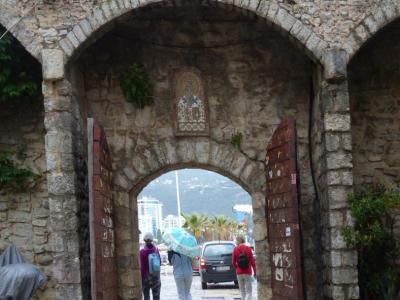
Porta di Terra Ferma (Mainland Gate), Budva
Mainland Gate stands as a testament to the town's medieval past and its connection to the Venetian Republic. In the city's early history, there were gates on all four sides of the walled city, including those facing the sea. Over time, the sea-facing gates were sealed off, leaving Mainland Gate as the primary entry point from the western side.
Mainland Gate serves as the grand entrance to Budva from the west. It leads visitors into Njegoševa Street, which is the town's primary thoroughfare. This gateway offers a glimpse into how access to the walled city was tightly controlled during medieval times. Above the gate, an ancient military observation post once stood sentinel. This post played a crucial role in safeguarding the city's security and was strictly off-limits to external disturbances.
Notably, above the unassuming doorway, you'll find the coat of arms of Stara Budva, signifying the Venetian period. This emblem features three eight-pointed stars and the image of a winged lion, the symbol of the Republic of Venice. It stands as an authentic representation of the medieval city of Budva.
Inside the main city gate, a mosaic icon serves as a poignant reminder of a centuries-old tradition. This icon, featuring the Virgin and Christ, once occupied a niche at this location. A perpetually lit lamp marked its presence, signifying the enduring spiritual significance of this spot.
Mainland Gate serves as the grand entrance to Budva from the west. It leads visitors into Njegoševa Street, which is the town's primary thoroughfare. This gateway offers a glimpse into how access to the walled city was tightly controlled during medieval times. Above the gate, an ancient military observation post once stood sentinel. This post played a crucial role in safeguarding the city's security and was strictly off-limits to external disturbances.
Notably, above the unassuming doorway, you'll find the coat of arms of Stara Budva, signifying the Venetian period. This emblem features three eight-pointed stars and the image of a winged lion, the symbol of the Republic of Venice. It stands as an authentic representation of the medieval city of Budva.
Inside the main city gate, a mosaic icon serves as a poignant reminder of a centuries-old tradition. This icon, featuring the Virgin and Christ, once occupied a niche at this location. A perpetually lit lamp marked its presence, signifying the enduring spiritual significance of this spot.
Want to visit this sight? Check out these Self-Guided Walking Tours in Budva. Alternatively, you can download the mobile app "GPSmyCity: Walks in 1K+ Cities" from Apple App Store or Google Play Store. The app turns your mobile device to a personal tour guide and it works offline, so no data plan is needed when traveling abroad.
Porta di Terra Ferma (Mainland Gate) on Map






Sight Name: Porta di Terra Ferma (Mainland Gate)
Sight Location: Budva, Montenegro (See walking tours in Budva)
Sight Type: Attraction/Landmark
Guide(s) Containing This Sight:
Sight Location: Budva, Montenegro (See walking tours in Budva)
Sight Type: Attraction/Landmark
Guide(s) Containing This Sight:
Walking Tours in Budva, Montenegro
Create Your Own Walk in Budva
Creating your own self-guided walk in Budva is easy and fun. Choose the city attractions that you want to see and a walk route map will be created just for you. You can even set your hotel as the start point of the walk.
Budva Introduction Walking Tour
Nestled along one of Europe’s most beautiful coastlines, Budva, without doubt, is one of the tourist capitals of Montenegro.
The name "Budva" (or Budua in Italian) carries echoes of the town's ancient past and is believed to have originated from the Illyrian word "Buthos," meaning ox. Dating back to the 5th century BC, the town was originally part of Illyria and later... view more
Tour Duration: 2 Hour(s)
Travel Distance: 1.3 Km or 0.8 Miles
The name "Budva" (or Budua in Italian) carries echoes of the town's ancient past and is believed to have originated from the Illyrian word "Buthos," meaning ox. Dating back to the 5th century BC, the town was originally part of Illyria and later... view more
Tour Duration: 2 Hour(s)
Travel Distance: 1.3 Km or 0.8 Miles

